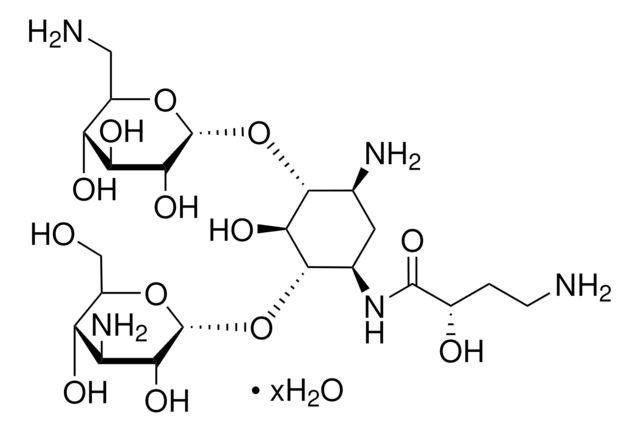T1783
Tobramycin sulfate salt
aminoglycoside antibiotic
Sinónimos:
Nebramycin Factor 6 sulfate
About This Item
Productos recomendados
origen biológico
Streptomyces tenebrarius
formulario
powder
potencia
634-739 μg per mg
condiciones de almacenamiento
(Keep container tightly closed in a dry and well-ventilated place. Hygroscopic.)
color
white to off-white
solubilidad
H2O: soluble 50 mg/mL
espectro de actividad antibiótica
Gram-negative bacteria
Modo de acción
protein synthesis | interferes
temp. de almacenamiento
2-8°C
cadena SMILES
OS(O)(=O)=O.NC[C@H]1O[C@H](O[C@@H]2[C@@H](N)C[C@@H](N)[C@H](O[C@H]3O[C@H](CO)[C@@H](O)[C@H](N)[C@H]3O)[C@H]2O)[C@H](N)C[C@@H]1O
InChI
1S/C18H37N5O9.H2O4S/c19-3-9-8(25)2-7(22)17(29-9)31-15-5(20)1-6(21)16(14(15)28)32-18-13(27)11(23)12(26)10(4-24)30-18;1-5(2,3)4/h5-18,24-28H,1-4,19-23H2;(H2,1,2,3,4)/t5-,6+,7+,8-,9+,10+,11-,12+,13+,14-,15+,16-,17+,18+;/m0./s1
Clave InChI
ZEUUPKVZFKBXPW-TWDWGCDDSA-N
Categorías relacionadas
Descripción general
Aplicación
Acciones bioquímicas o fisiológicas
Mode of Action: Binds to 70S ribosomal subunit; inhibits translocation; elicits miscoding.
Spectrum of Activity: Gram negative bacteria. Not effective against Enterococci.
Envase
Precaución
Otras notas
Palabra de señalización
Danger
Frases de peligro
Consejos de prudencia
Clasificaciones de peligro
Acute Tox. 4 Dermal - Acute Tox. 4 Inhalation - Repr. 1B
Código de clase de almacenamiento
6.1C - Combustible acute toxic Cat.3 / toxic compounds or compounds which causing chronic effects
Clase de riesgo para el agua (WGK)
WGK 3
Punto de inflamabilidad (°F)
Not applicable
Punto de inflamabilidad (°C)
Not applicable
Equipo de protección personal
Eyeshields, Gloves, type P3 (EN 143) respirator cartridges
Certificados de análisis (COA)
Busque Certificados de análisis (COA) introduciendo el número de lote del producto. Los números de lote se encuentran en la etiqueta del producto después de las palabras «Lot» o «Batch»
¿Ya tiene este producto?
Encuentre la documentación para los productos que ha comprado recientemente en la Biblioteca de documentos.
Los clientes también vieron
Artículos
Antibiotics targeting bacterial ribosomes disrupt protein synthesis, a key process in bacterial growth inhibition.
Nuestro equipo de científicos tiene experiencia en todas las áreas de investigación: Ciencias de la vida, Ciencia de los materiales, Síntesis química, Cromatografía, Analítica y muchas otras.
Póngase en contacto con el Servicio técnico











